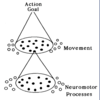Taxonomy Of Tasks Flashcards
GOAL DIRECTED BEHAVIORS are guided by what?
- by the consequences it produces
- by feedback that inform us as to how close or how far we are from accomplishing our objective.
What is a Goal Directed Behavior?
aimed at a specific purpose; it’s intentional; linked to outcomes.
What are the three types of goal directed behaviors?
- Investigatory behavior
- Functional behavior
- Communicative behavior (not covered in this class)
What is the type of behaviors used to orient, focus or adjust our sensory analyzers to best gather information?
Investigatory behavior
What type of behavior is used to localize the source of a sound moving the head sideways so that the pressure patterns arriving at the two ears differ in time?
Investigatory behavior
What type of behavior uses mouth and tongue movements to enhance gustatory input and we sniff to amplify olfactory cues?
Investigatory behavior
What type of behavior enable us to cope with our everyday physical surroundings and are of most interest to rehabilitation therapist?
Functional behaviors
What type of behaviors include walking forward to pick up and object; carrying a child while crossing a busy street; sitting while holding a newspaper so as to read?
Functional behavior
Functional behaviors can be analyzed on three levels:
- Action 2. Movements 3. Neuromotor process
To infer that an ACTION has taken place, is it necessary to observe the performer’s movement?
No. Action is defined by the end-state or outcome resulting from performer-environment interaction and does not implicate how that end is achieved.
What is the relationship between action, movement, and Neuromotor process?
- Not one-to-one: many movements can used to achieve an action-goal.
- Similarly, neuromotor processes can be organized in many ways to have a particular movement emerge.

What is a SKILL?
- Consistently attaining and action-goal with some economy of effort.
- It involves and individual solution to the problem
Can a person use one single movement pattern to sit on different chairs?
No.
Is SKILL task-specific?
Yes. Ex. The movement pattern used to sit on a wooden chair with arm rests cannot be used to sit on a stool. When the task changes the demands placed on the performer changes too.
Tasks are analyzed from two perspectives:
- The environmental context
- The action’s functional role
In evaluating the environmental context, tasks are categorized as Which 2 types of tasks?
- The regulatory conditions during a performance
- By determining whether these conditions change from one attempt to the next. (Intertrial variability)
(motion in the environment or no motion)
Putting on a sweater, and buttoning a shirt, are examples of which task category?
Stationary environment
Sitting on a moving train is an example of what type of task?
-Motion in the environment CONSISTENT MOTION TASKS
Catching a thrown ball is an example of what type of task?
CONSISTENT MOTION TASKS -Motion in the environment
Moving through a revolving door is what type of task?
Consistent motion task
Which type of task is the one in which the movement’s timing is determined by the external environment?
Consistent motion task
In knitting while watching television is INTERTRIAL VARIABILITY present or absent?
Absent. -High predictability of the environment saves attentional-resources
Is there INTERTRIAL VARIABILITY When the environmental context changes from one attempt to the next?
Yes.
True or false: performance under variable conditions can be characterized as “CONTROLLED” in contrast to the “AUTOMATIC” performance observed when conditions are constant.
True


